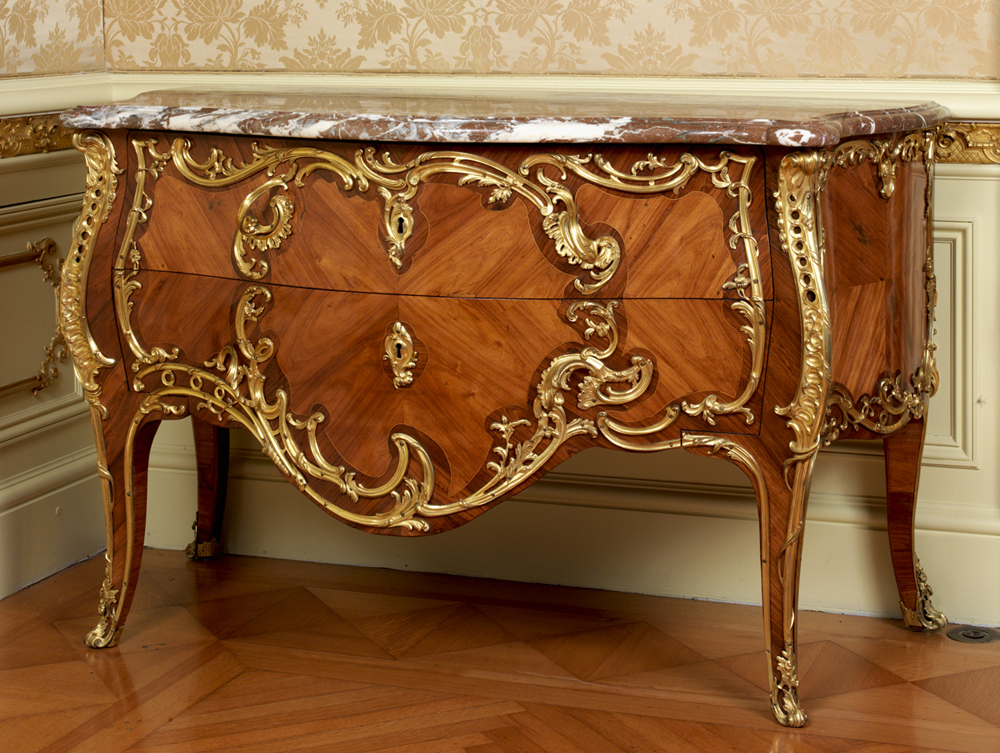
Palm Beach’s Henry Morrison Flagler Museum turned 50 last week. To commemorate this special anniversary, local collectors Leon and Charlotte Amar announced a generous gift of forty-one examples of fine and decorative arts from their collection. The Amar gift—the museum’s largest to date—is valued at $2,657,000, and includes European paintings, prints, French furniture and rugs, and Asian artifacts. Of note are English paintings from the 18th and 19th centuries by Richard Parkes Bonington, Sir Thomas Lawrence, Henry Courtney Selous, and George Romney, as well as 19th-century pastel portraits by Jean-Étienne Liotard and Jean Valade. Additionally, the Amar gift features many significant examples of Chinese decorative art, such as a pair of Qing Dynasty vases and a Zhou dynasty bronze vessel.
The highpoint of the gift, however, is undoubtedly a Louis XV bombé commode made in 1761 by the French ébéniste Léonard Boudin (1735-c.1804). It is currently on view in the Music Room of Whitehall, Flagler’s 55-room mansion—designed by Carrere and Hastings and completed in 1902—which houses the museum’s collection and exhibitions. Reflecting the Gilded Age taste for historical eclecticism, its interiors, commissioned from the New York firm of Pottier and Stymus, embrace a variety of period styles. The Music Room, which was intended to emulate a French-style opera house and includes a 1,249-pipe J.H. & C.S. Odell Co. organ, makes a fitting backdrop for Boudin’s luxurious rococo commode.
Boudin apprenticed with Pierre III Migeon, the renowned French marchand-ébéniste, or furniture dealer, and developed formidable skills in intricate floral marquetry, and Chinese lacquer and vernis panels. He was received as a master and joined the cabinetmaker’s guild in 1761, the same year this commode was made, which securely documents it to his own hand.
One striking feature, which the museum’s chief curator Tracy Kamerer points out is a favorite of visitors, are the unusual pierced ormolu mounts in the form of crisscrossed ribbons on each side of the commode. The vigorous asymmetry of the mounts is a perfect foil to the simple leaf veneering on the drawer and side panels. Kamerer also notes that, in addition to Boudin’s own marks, the piece bears the inventory marks of the 12th Earl of Derby, a well-known collector of French furniture and a patron of the architect Robert Adam.
Boudin’s work was quickly sought after by important clients for its high level of workmanship and innovation, and by 1772 he had become a marchand-ébéniste himself. He plied this lucrative trade for nearly two decades, often retailing items he commissioned from other craftsmen, such as Charles Topino, Nicolas Petit, André-Louis Gilbert, and Pierre Denizot. He did not give up his own craft entirely, however, and fostered close creative relationships with the artisans in his employ, often resulting in jointly designed pieces. After the French Revolution Boudin gave up the furniture trade, turning instead to work as a decorator and upholsterer.
Have you seen Boudin’s work first hand, or know of examples in other museum collections? Leave a comment below and let us know.
